Binocular Comet ZTF! Comet C/2022 E3 (ZTF), or ZTF E3 for short, has been brightening ever since the automated Zwicky Transient Facility discovered it at 17th magnitude last March. Now it's finally having its best time in the sun while crossing the northern sky. As of January 25th it's about magnitude 5.5, on its way to maybe 5.2 when brightest around the end of January and the beginning of February.
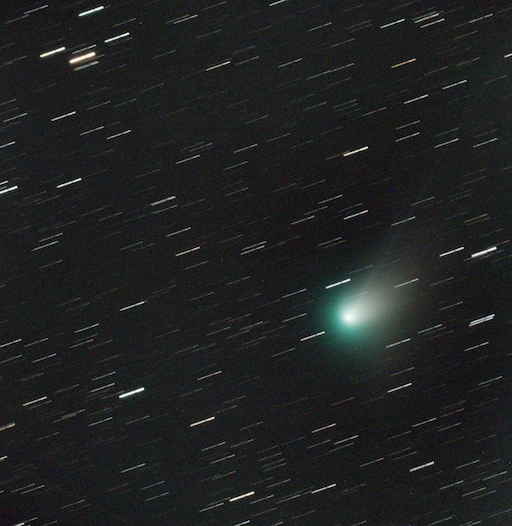
The comet is in reach of binoculars even through a somewhat light-polluted sky — if you have a chart that pinpoints the location to examine each night, and if you know the constellations well enough to match the chart to the stars in your sky outdoors. For the last week the comet has even been dimly visible to the naked eye in a very dark, moonless sky — again, if you know the right spot to examine.
See Bob King's article Circumpolar Comet ZTF (C/2022 E3) is Here! It has the finder chart you need as well as a table of the best observing times by date and the moonlight situation. On the chart, the dates on the comet's track are for oh Universal Time, which falls on the evening of the previous date in North America.
As of Wednesday night January 25-26 the comet is entering Ursa Minor near the bowl of the Little Dipper. It's fairly well up in the north by mid-evening, depending on your latitude, and gains some altitude for the rest of the night. The waxing crescent Moon is not yet a problem and in any case sets around 11 pm.
Comet ZTF passes Kochab on the North American night January 27th and Polaris on the 29th and 30th. But by then moonlight will pose growing interference in the evening, with the waxing Moon setting later and later in the night. There will be bright moonlight all night from dusk to dawn from February 2nd or 3rd through the 6th. Then a good moonless window will begin opening in the evening around February 7th, with the comet probably fading.
FRIDAY, JANUARY 20
■ Sirius twinkles brightly after dinnertime below Orion in the southeast. Around 8 or 9 p.m., depending on your location, Sirius shines precisely below fiery Betelgeuse in Orion's shoulder. How accurately can you time this event for your location, perhaps judging against the vertical edge of a building? Of the two, Sirius leads early in the evening. Betelgeuse leads later.
Continue the line from Betelgeuse through Sirius on down, and it runs right along Canis Major's back by another 10° to the dog's rear end: Delta Canis Majoris, or Wezen, the middle star of Canis Major's bright rear triangle.
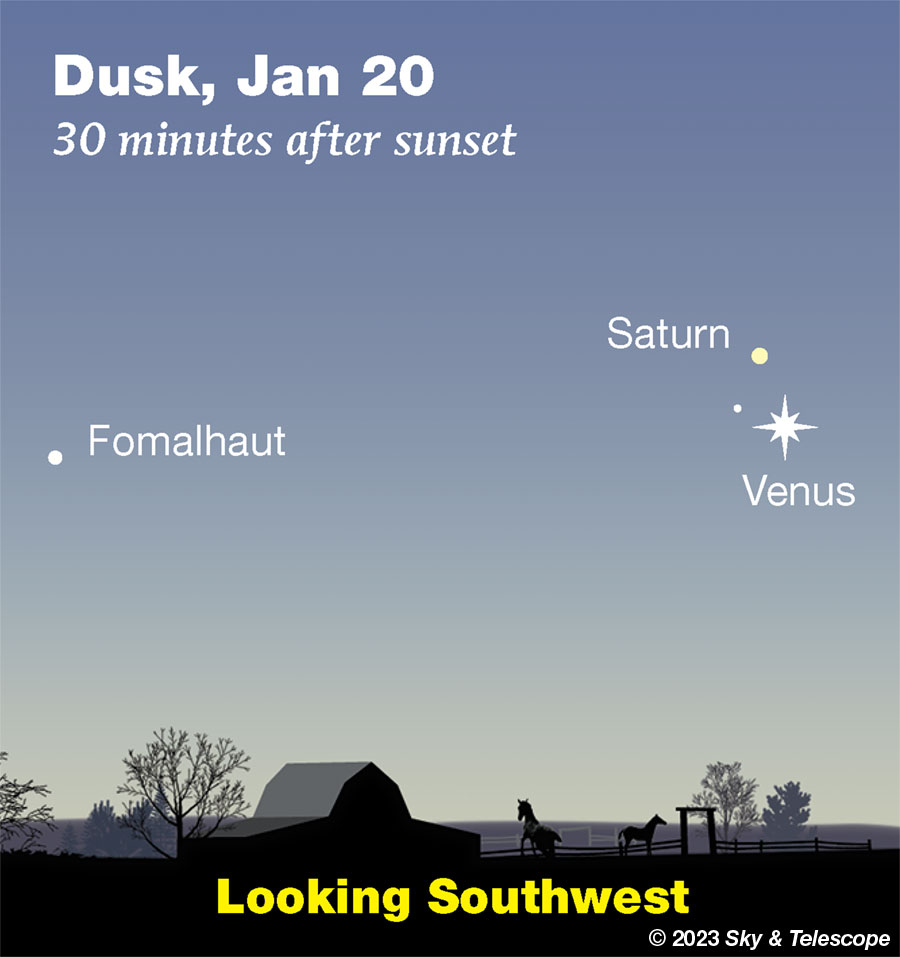
SATURDAY, JANUARY 21
■ Zero-magnitude Capella high overhead, and equally bright Rigel in Orion's foot, have almost the same right ascension. This means they cross your sky’s meridian at almost exactly the same time: around 9 or 10 p.m. now, depending on how far east or west you live in your time zone. So, whenever Capella passes its very highest, Rigel always marks true south over your landscape, and vice versa.
Capella goes exactly through your zenith if you're at latitude 46° north: Portland, Oregon; Montreal; Portland, Maine; central France; Odesa.
■ Algol tonight should be at minimum brightness, magnitude 3.4 instead of its usual 2.1, for a couple hours centered on 12:27 a.m. EST; 9:27 p.m. PST.
■ New Moon (exact at 3:53 p.m. EST.)
SUNDAY, JANUARY 22
■ Venus and Saturn reach conjunction ½° apart, as shown below. Use binoculars in bright twilight. And look too for the thin crescent Moon rather far below them.
Both planets will fit together in a telescope's low- to medium-power eyepiece. You will be struck by how radically different the surface brightnesses of Venus and Saturn really are! Saturn is 13.5 times farther from the Sun than Venus is, so its clouds are lit by sunlight that's 13.52 or 180 times fainter than the sunlight striking Venus.
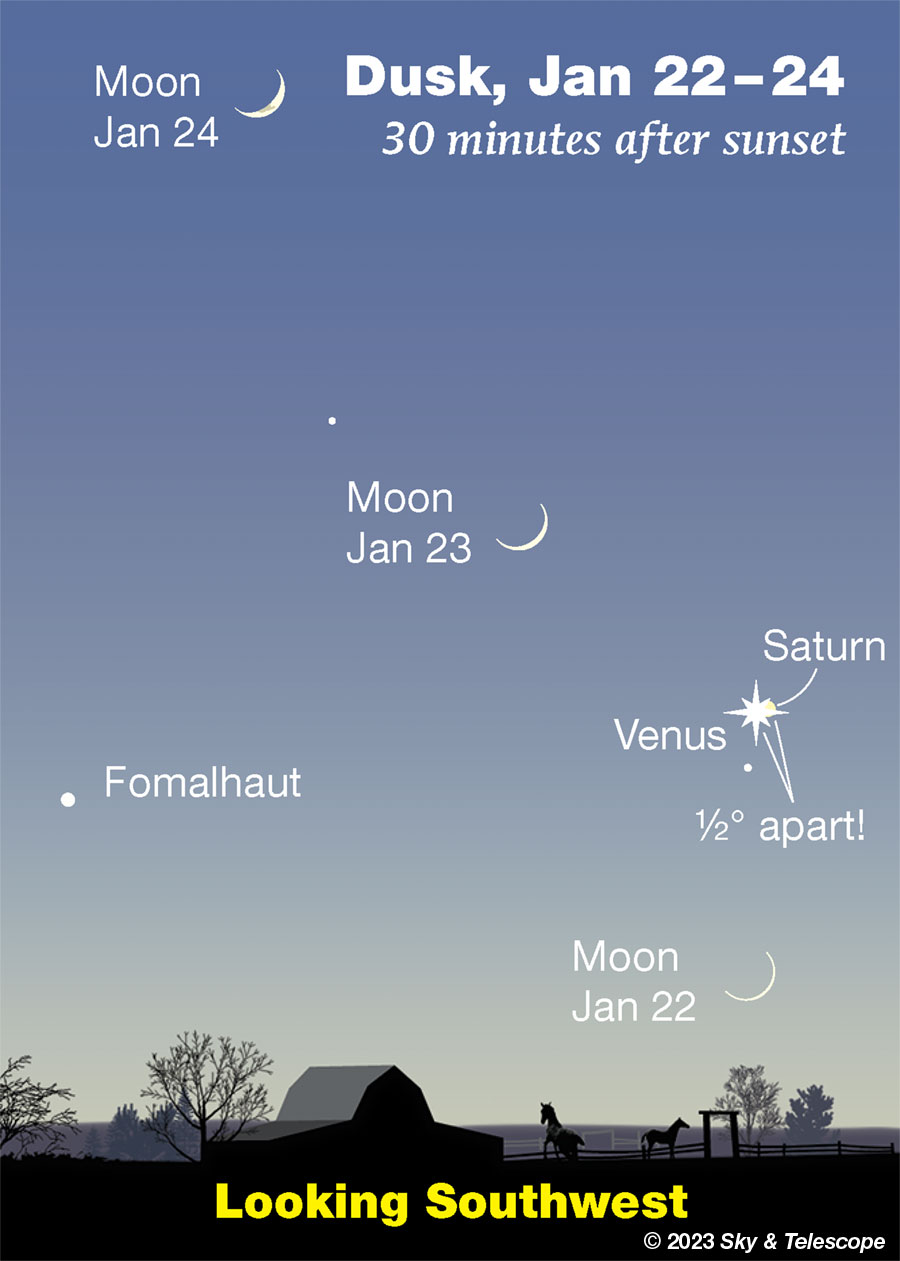
MONDAY, JANUARY 23
■ Now Saturn glimmers 1.3° to Venus's lower right in the fading twilight, while the crescent Moon looks on from the upper left.
TUESDAY, JANUARY 24
■ The big Northern Cross in Cygnus, topped by Deneb, is roughly upright in the west-northwest after dark. By 6 or 7 p.m. it's standing on the horizon. How upright it stands there depends on your latitude.
■ Algol should be at minimum brightness for a couple hours centered on 9:16 p.m. EST.
WEDNESDAY, JANUARY 25
■ Right after dark, face east and look very high, almost overhead. The bright star there is Capella, the Goat Star. To the right of it, by a couple of finger-widths at arm's length, is a small, narrow triangle of 3rd and 4th magnitude stars known as "The Kids." Though they're not exactly eye-grabbing, they form a never-forgotten asterism with Capella.
THURSDAY, JANUARY 26
■ After dark the Great Square of Pegasus sinks in the west left of Jupiter. It's tipped onto one corner. Meanwhile the Big Dipper is creeping up in the north-northeast, tipped up on its handle.
FRIDAY, JANUARY 27
■ Orion is now high in the southeast right after dark, and he stands highest due south around 9 p.m. Orion is the brightest of the 88 constellations, but his main pattern is surprisingly small compared to some of his dimmer neighbors. The biggest of these is Eridanus the River to his west, enormous but hard to trace. Dimmer Fornax the Furnace, to Eridanus's lower right, is almost as big as Orion! Even the main pattern of Lepus, the Hare cowering under the Hunter's feet, isn't much smaller than he is.
Do you know the constellation down below Lepus? It's a tough one: Columba the Dove, faint, sprawly, and to my eye not a bit dove-like. See the constellation chart in the center of the February Sky & Telescope. Its brightest star, Alpha Columbae or Phact, is magnitude 2.6. To find it, draw a line from Rigel through Beta Leporis (the front of the bunny's neck) and extend it an equal distance straight on.
SATURDAY, JANUARY 28
■ First-quarter Moon (exactly so at 10:19 a.m. EST). The Moon is partway between Mars to its left and Jupiter farther to its lower right. During twilight Venus and Saturn complete the lineup low in the west-southwest; a line from the Moon through Jupiter points to them — because, of course, they all lie nearly on the great circle of the ecliptic. Uranus and Neptune are also part of the evening lineup, out of naked-eye sight.
SUNDAY, JANUARY 29
■ The waxing gibbous Moon shines on the edge of Taurus somewhat west of the Pleiades, Mars, and Aldebaran, as shown below.
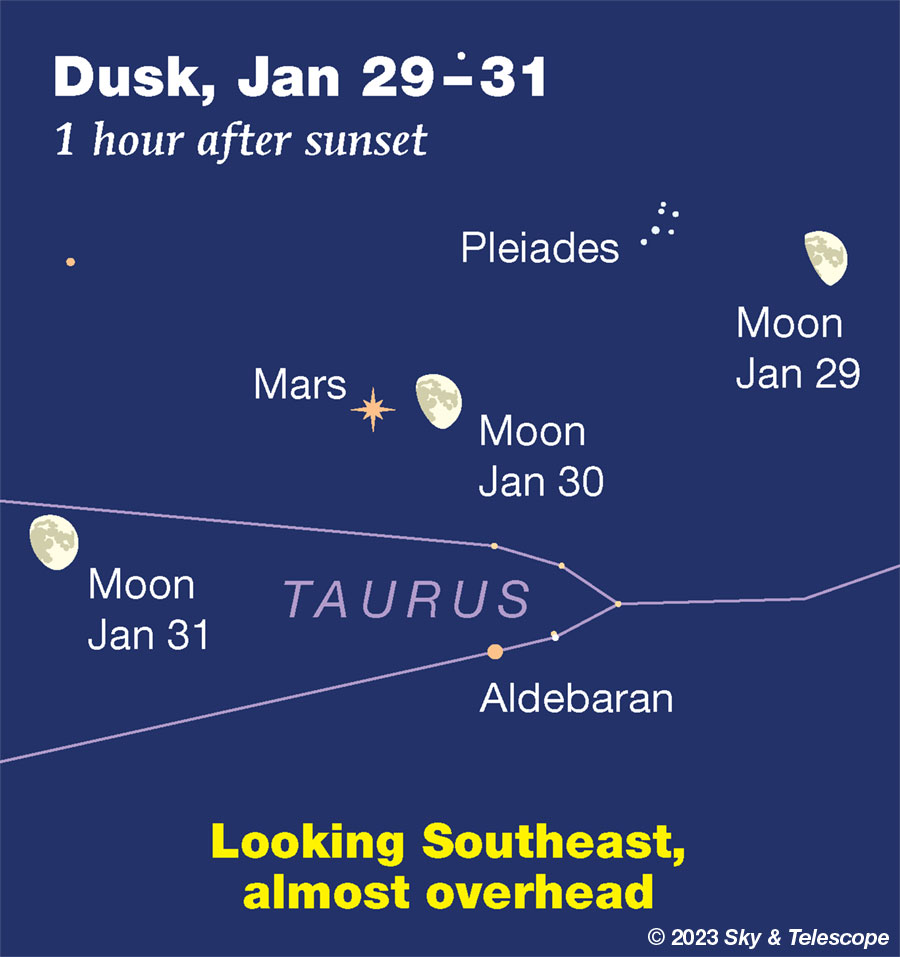
Tomorrow night January 30th, the Moon's dark limb will occult Mars for the southern US from north Florida through central California, and south into northwestern South America. Skywatchers elsewhere in the Americas will observe a near miss. Map and timetables.
This Week's Planet Roundup
Mercury is having a nice dawn apparition. Starting about 50 minutes before your local sunrise, look for it low in the southeast. It's the brightest thing there, shining at about magnitude 0.0 all week.
Don't confuse it with Antares about three fists to its right or upper right. Or Altair a little farther to Mercury's left or upper left.
Venus, very bright at magnitude –3.9, shines low in the west-southwest in evening twilight. It sets just after twilight's end. Dimmer Saturn passes it this week. They go through conjunction on January 22nd about ½° apart, as shown at the top of this page. Thereafter Saturn descends rapidly away to Venus's lower right.
Mars, in Taurus, shines very high toward the south in early to mid-evening. Mars continues to fade, from magnitude –0.6 to – 0.4 this week, as it shrinks from 12 to 11 arcseconds wide. Aldebaran, mag +0.8, is 8° below it.
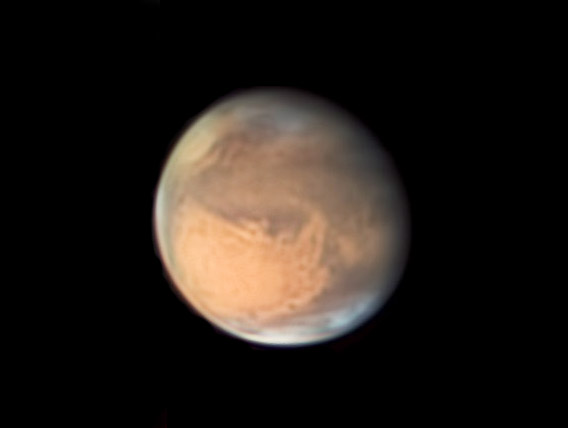
South here is up. Sinus Meridiani with its two downward prongs is at center. Sinus Sabaeus is the dark band running left from there. Through northern clouds, the whiter north polar cap is visible. Syrtis Major is departing on the left limb. Hellas Basin, above Syrtis Major, has turned bright with cloud or frost.
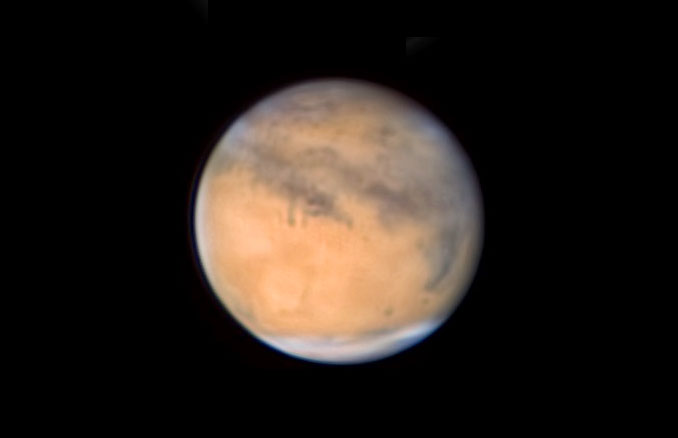
Jupiter, magnitude –2.2 in Pisces, shines high in the southwest in twilight, then sinks toward the west. It sets around 10 p.m. Telescopically, Jupiter has shrunk to 37 or 36 arcseconds wide.
Look for the Great Square of Pegasus to Jupiter's right. Extend the line of the Square's upper left side down to the planet. Jupiter crosses this line on Monday January 23rd. To help judge this, hold a straightedge up to the sky or stretch a string tightly between your hands.
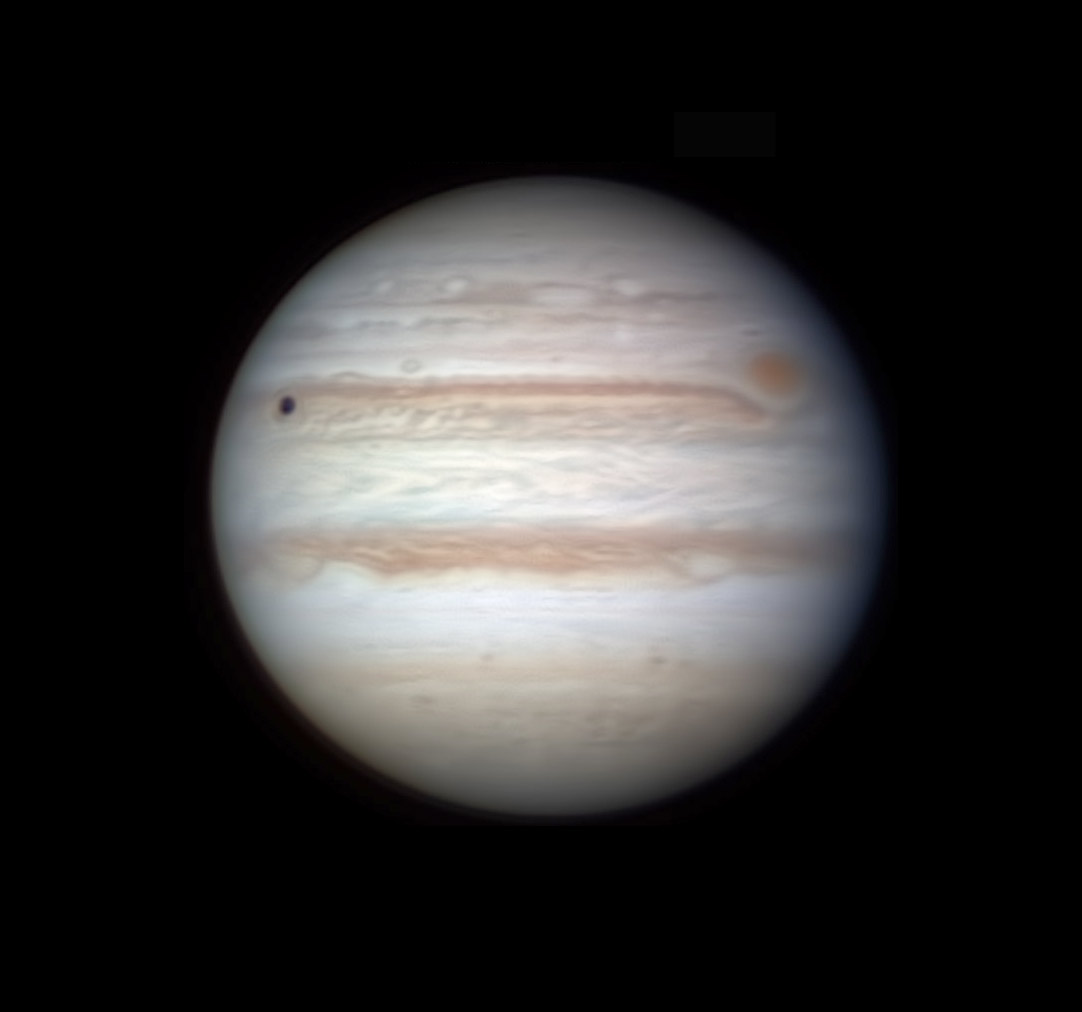
Writes Go, "This is my first image of the year. Monsoon had been horrible. Imaging Jupiter has become very challenging. It is getting lower in the sky and closer to my hot roof. Seeing was very unstable." The Great Red Spot is rotating onto the disk from the east. The black dot is the shadow of Io. "I used the new WinJupos feature of [Galilean] moon derotation [in addition to the standard derotation of the planet during a long series of stacked video frames], and it works perfectly!"
Saturn, magnitude +0.8 in Capricornus, passes brilliant Venus this week in the twilit southwest. On Friday January 20th, Saturn is still 2° above Venus as shown at the top of this page. They go through conjunction on the 22nd, about ½° apart. Thereafter Saturn descends rapidly away to Venus's lower right.
Uranus, magnitude 5.7 in southern Aries, is high in the south in early evening. It displays a tiny, very slightly blue-greenish gray disk 3.6 arcseconds wide. It a telescope at high power it's obviously non-stellar. See the Uranus finder charts in the November Sky & Telescope, page 49.
Neptune, magnitude 7.9 at the Aquarius-Pisces border, is getting lower about 10° to the lower right of Jupiter. So try for it immediately after dark. Neptune is just 2.2 arcseconds wide, again non-stellar in a telescope but requiring more effort than Uranus. See the Neptune finder charts in last September's Sky & Telescope, page 49.
All descriptions that relate to your horizon — including the words up, down, right, and left — are written for the world's mid-northern latitudes. Descriptions and graphics that also depend on longitude (mainly Moon positions) are for North America.
Eastern Standard Time (EST) is Universal Time minus 5 hours. Universal Time is also called UT, UTC, GMT or Z time.
Want to become a better astronomer? Learn your way around the constellations. They're the key to locating everything fainter and deeper to hunt with binoculars or a telescope.
This is an outdoor nature hobby. For an easy-to-use constellation guide covering the whole evening sky, use the big monthly map in the center of each issue of Sky & Telescope, the essential magazine of astronomy.
Once you get a telescope, to put it to good use you'll need a detailed, large-scale sky atlas (set of charts). The basic standard is the Pocket Sky Atlas (in either the original or Jumbo Edition), which shows stars to magnitude 7.6.

Next up is the larger and deeper Sky Atlas 2000.0, plotting stars to magnitude 8.5; nearly three times as many. The next up, once you know your way around, are the even larger Interstellarum atlas (stars to magnitude 9.5) or Uranometria 2000.0 (stars to magnitude 9.75). And be sure to read How to Use a Star Chart with a Telescope. It applies just as much to charts on your phone or tablet as to charts on paper.
You'll also want a good deep-sky guidebook. A beloved old classic is the three-volume Burnham's Celestial Handbook. An impressive more modern one is the big Night Sky Observer's Guide set (2+ volumes) by Kepple and Sanner.
Can a computerized telescope replace charts? Not for beginners, I don't think, and not on mounts and tripods that are less than top-quality mechanically, meaning heavy and expensive. And as Terence Dickinson and Alan Dyer say in their Backyard Astronomer's Guide, "A full appreciation of the universe cannot come without developing the skills to find things in the sky and understanding how the sky works. This knowledge comes only by spending time under the stars with star maps in hand."
![]() Audio sky tour. Out under the evening sky with your
Audio sky tour. Out under the evening sky with your
earbuds in place, listen to Kelly Beatty's monthly
podcast tour of the heavens above. It's free.
"The dangers of not thinking clearly are much greater now than ever before. It's not that there's something new in our way of thinking, it's that credulous and confused thinking can be much more lethal in ways it was never before."
— Carl Sagan, 1996
"Facts are stubborn things."
— John Adams, 1770
 6
6









Comments
misha17
January 20, 2023 at 12:32 pm
It's just outside this article's timeline, but the Moon will once again occult Mars for viewers in the southern U. S. on the night of Monday January 30. Occultation will be viewable south of a line running roughly from near San Francisco to northern Florida; the Moon will pass just south of Mars for viewers north of that line.
Map of viewing area and disappearance/reappearance times for selected cities can be found here:
http://www.lunar-occultations.com/iota/planets/0131mars.htm
You must be logged in to post a comment.
Rod
January 21, 2023 at 3:43 am
Early this morning, I posted a comet observation update report at, https://skyandtelescope.org/astronomy-news/spot-circumpolar-comet-ztf-c-2022-e3-in-binoculars/
C/2022 E3 ZTF is now about 5.9 magnitude compared to 8.59 when I first started viewing on 24-Dec-2022. Easier to see now in 10x50 binoculars and better views using my 90-mm refractor telescope.
You must be logged in to post a comment.
New Jersey Eclipse Fan
January 23, 2023 at 2:26 pm
As a follow-up to my January 8 post in the January 6 online edition of S&T--specifically on the story about the late Akira Fujii (if anyone cares)--I just realized that Fiji (& Fijian, of course) are also members of the 3-dotted-letters-in-a-row club! Any others?
You must be logged in to post a comment.
Rod
January 24, 2023 at 6:58 am
I did enjoy some more observations of C/2022 E3 (ZTF) early today.
Observed 0200-0330 EST. First Quarter Moon 28-Jan-2023 1519 UT. Easy to locate C/2022 E3 (ZTF) comet this morning. Theskylive.com reports magnitude 5.6 now. Stellarium 1.2 shows C/2022 E3 (ZTF) about 1 degree 51 arcminute angular separation from Edasich in Draco when I started observing. Distinct, bright 10x50 binocular view and simple to locate using Telrad with my 90-mm refractor telescope. I used TeleVue 14-mm Delos eyepiece (71x) for a bit more than 60-arcminute true FOV along with 10x50 binoculars. Draco stars HIP74756 (7.60 magnitude) and TYC4181-1286-1 (8.90 magnitude) are about 8 arcminutes apart from each other, visible in the FOV with the comet. C/2022 E3 (ZTF) distinct coma about same angular size (8 arcminutes), visible with slight fan shape and some tail now, perhaps 15-20 arcminutes faintly visible across the FOV at 71x using. Stellarium 1.2 reports coma diameter about 17 arcminutes or so and gas tail length close to 1.5-degrees. Other fainter stars visible along with C/2022 E3 (ZTF). This was fun comet observing with clear skies, temperature -2C, winds 280/5 knots. I started observing comet C/2022 E3 (ZTF) on 24-Dec-2022 when magnitude 8.59 was reported. I did not see unaided eyes because of light pollution towards N and NE sectors, I can see about 5.0 or so magnitude stars in those directions but very easy using 10x50 binoculars now and 90-mm refractor telescope. The woodburning stove was running when I came back inside.
You must be logged in to post a comment.
New Jersey Eclipse Fan
January 24, 2023 at 10:49 am
I was motivated to do some stargazing tonight, but now I'm in the mood for S'mores.
You must be logged in to post a comment.
Collin
January 26, 2023 at 12:02 pm
Does anyone know of a good sketch or photo of the Venus-Saturn conjunction on Sunday, night, January 22nd? So far, the best I've found is this ...
https://astronomy.com/-/media/Images/News%20and%20Observing/Sky%20this%20Week/STW%202023/01%20Jan/venussaturn.jpg?mw=1000&mh=800
That's nice, but doesn't show Titan. I distinctly saw Titan. Certainly someone on planet Earth took a photo or made a sketch that shows that level of detail.
You must be logged in to post a comment.
You must be logged in to post a comment.